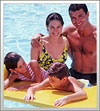| Swimming lessons and the cost conundrum | |
By now we all know swimming is a life skill. But making the commitment to quality swimming lessons for your children can quickly add up.
 The biggest questions that I am asked are: 1. How long will it take my child to swim? 2. How many times a week should my child have a swimming lesson? | |
| How long will it take my child to swim? | |
Becoming a safe swimmer depends on a number of variables:
| |
How many lessons should you do a week?
| |
Of course, more lessons are better for faster results. Less time between lessons helps reduce potential anxiety that can build up, as well as keep muscle memory intact.
But what is more important is consistency.

When budgeting, it is important to think year long or with as little breaks as possible. Swimming lessons taken year round keep building on this life skill and will maintain proper efficient swimming form, which is key to being a confident, safe swimmer.
| |
How to see the results for your budget
| |
When looking at your budget aim for an "in the water"
 goal of 2-4 times a week for the first month or two. After the initial two months, evaluate your situation and make changes according to your child's skill level. Make sure to factor in lesson cost, community pool play costs, driving costs, parking costs, supply costs such as swim diapers, goggles, sun block, and bathing suits. goal of 2-4 times a week for the first month or two. After the initial two months, evaluate your situation and make changes according to your child's skill level. Make sure to factor in lesson cost, community pool play costs, driving costs, parking costs, supply costs such as swim diapers, goggles, sun block, and bathing suits. | |
"In the water" budgeting options
| |
If you can only budget for one lesson a week, then add 1-3 days per week of "family fun time" at your local community pool. Community pools offer low rates to swim.
 Going to the pool with your child shows him or her that the pool is a source of fun and helps to build a wonderful life long water bond. It opens up the opportunity for your children to explore the water with the safety of family and most importantly, it allows them to practice. Going to the pool with your child shows him or her that the pool is a source of fun and helps to build a wonderful life long water bond. It opens up the opportunity for your children to explore the water with the safety of family and most importantly, it allows them to practice. Learning any new skill is about practice. Spending time in a pool as a family can also make the swim instructor's job easier as your child has more time to learn how to enjoy the water. This should equate to savings in your wallet. By increasing your child's exposure to the water, you will accelerate their learning. | |
Making swimming part of your everyday
| |
Turn as many opportunities as you can into how swimming and swimming lessons are fun. In the tub practice exploring the water for treasures, back floating, even kicking!
 At the table blow bubbles into a glass of milk. Dress up your child's favorite toy with swim gear and create a swimming adventure.Go to the beach and watch the surfers and boogies boarders. At the table blow bubbles into a glass of milk. Dress up your child's favorite toy with swim gear and create a swimming adventure.Go to the beach and watch the surfers and boogies boarders.
Rent Finding Nemo, The Little Mermaid, and Lilo and Stitch.
There are endless opportunities to make swimming part of your everyday life.
| |



 options and which is right for you?
options and which is right for you? If your child is 24 months and under, parent a
If your child is 24 months and under, parent a





 ADD, ADHD, Anxiety
ADD, ADHD, Anxiety




